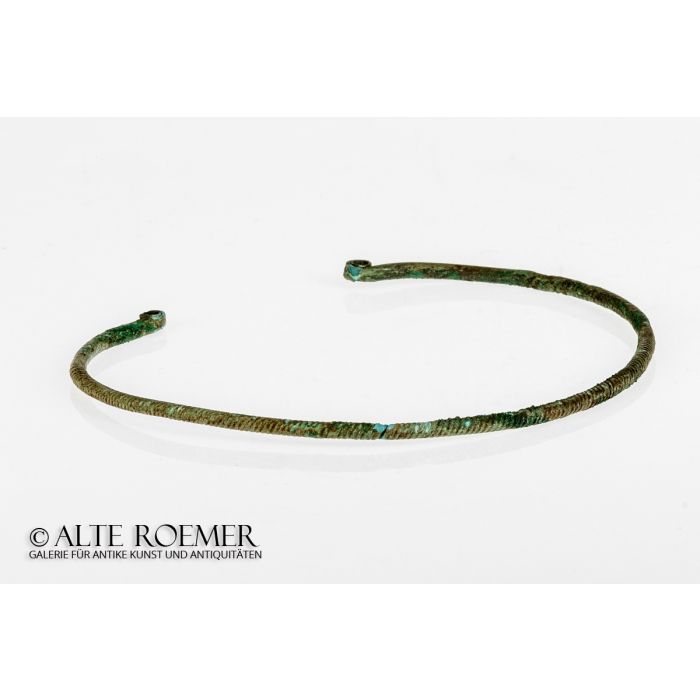Neck ring of the Urnfield culture
Price: on request
Sold
Object number
AR2691
| Object: |
Neck ring of the Urnfield culture
|
| Material: |
Bronze.
|
| Period: |
Early Urnfield period, c. 1300 BC to 1050 BC. Late Bronze Age in Central Europe. |
| Description: |
Open neck ring made of solid bronze with a circular cross-section. The terminals are flattened and rolled into spirals. The surface of the ring is smooth towards the terminals, but the rest of the ring surface is decorated with spirals creating the impression of a twisted bronze rod. This piece is an early type of a torc or torque, a type of jewellery that became famous by its mention in the historical descriptions of the later Celtic cultures. |
| Background: |
The end of the second millenium before our era was a time of upheaval in Central Europe. The changes in culture and politics can also be seen in the archaeological evidence.
For example in the wide spread use cremation burials. But also in the grave goods coming with that new tradition. The ashes of the deceased were placed in pottery vessels and covered with a pottery bowl or a flat stone. One big urn was accompanied by four to six smaller vessels. The metal objects for burial were mostly made of Bronze, but now also the first objects made of iron appear in Central European graves. This indicates that the Urnfield period was a transitional phase between Bronze Age and Iron Age. Thanks to the Urnfield culture burials many objects from that exciting period have been preserved until today. |
| Dimensions: |
156mm x 142mm out dimensions. 149mm x 134mm inner dimensions.
|
| Condition: |
Good condition. Broken at one spot, but still connected. Otherwise fully intact body with a nice polychrome patina.
|
| Provenance: |
Acquired by us in 2019 from the German Rehorik family collection. The collection was built in the 1960ies and 1970ies by Hugo Rehorik. It consists entirely of archeological finds from the region around Regensburg in Germany. Hugo Rehorik (1905-1979) was working in the Regensburg area as an voluntary archeologist, mostly together with Hans-Jürgen Werner (1941-1997) and with the help of Gerhard and Robert Pleyer. The team supported the Landesamt für Denkmalschutz (state department of cultural heritage preservation) with the recovery of artefacts. This support was of great importance because the 1960ies saw the advent of deep plowing in Germany. Artefacts in the ground needed to be saved from destruction by the new agricultural machines quickly. The state archeologists praised this cooperation highly. It is a nice example of volunteers and professionals working together to preserve our cultural heritage. And also a role model urgently needed for today's situation in archeology. The finds were documented and examined according to scientific standards. Intricate restorations were performed by Heinz Rademacher (1929-1992) who worked for the städtische Museum Regensburg (city museum of Regensburg). Most pieces were then given to museums, namely the Historische Museum in Regensburg (Regensburg historical museum), the Naturkundemuseum Regensburg (Regensburg natural history museum) and the archäologische Staatssammlung in München (archeological state collection of Munich). Individual pieces have been split among the volunteers with the consent of the state archeologists. This way the Rehorik collection came into existence. |
| References: |
Cf. Detert Zylmann, Veröffentlichungen der pflälzischen Gesellschaft zur Förderung der Wissenschaften in Speyer, Band 72, Die Urnenfelderkultur in der Pfalz, Grab. und Depotfunde, Einzelfunde aus Metall (1983), plate 63, B. Similar Ingo Motzenbäcker, Sammlung Kossnierska (1996), p. 124, and plate. 13, no. 9. and plate 31, no. 10. Similar Schätze der Vorzeit aus dem Depot des Landesmuseums (1987), p. 41, bottom right. For information on rings with imitated twisting cf. Gretel Gallay, Archäologische Reihe 9, vorgeschichtlicher Schmuck, p. 33. |
| Literature on the Rehorik collection: |
S. Kuchlmayr, Vom Tertiär zur Römerzeit: Hugo Rehorik u. seine Funde, in Regensburger illustriertes Stadtmagazin no. 3 / 5 (1979), pages 14f. A. Stroh, Bericht der vorgeschichtlichen Abteilung des Museums Regensburg (1965), mentions Hugo Rehorik's relation to numerous finds and research results; Stroh is praising Rehorik's contributions as an amateur archaeologist. F. D. Davis, Neue bandkeramische Gräber von Mangolding (1968), the book deals among other topics with an excavation in which Hugo Rehorik took part in. H. T. Fischer, Archäologische Ausgrabungen und Funde in der Oberpfalz (1982) mentions Hugo Rehorik and explains how thankful the local archaeologist are for their volunteers. T. Fischer, Im memoriam Hans-Jürgen Werner, in Acta Albertina Ratisbonesia 50/2, pages 231ff (1997), the memorandum includes a very good summary of the cooperation with Hugo Rehorik and the situation and working methods in the 1960ies and 1970ies. |
| Authenticity: |
We unconditionally guarantee the authenticity of every artefact, all items are subject to our lifetime return policy on authenticity.
|


